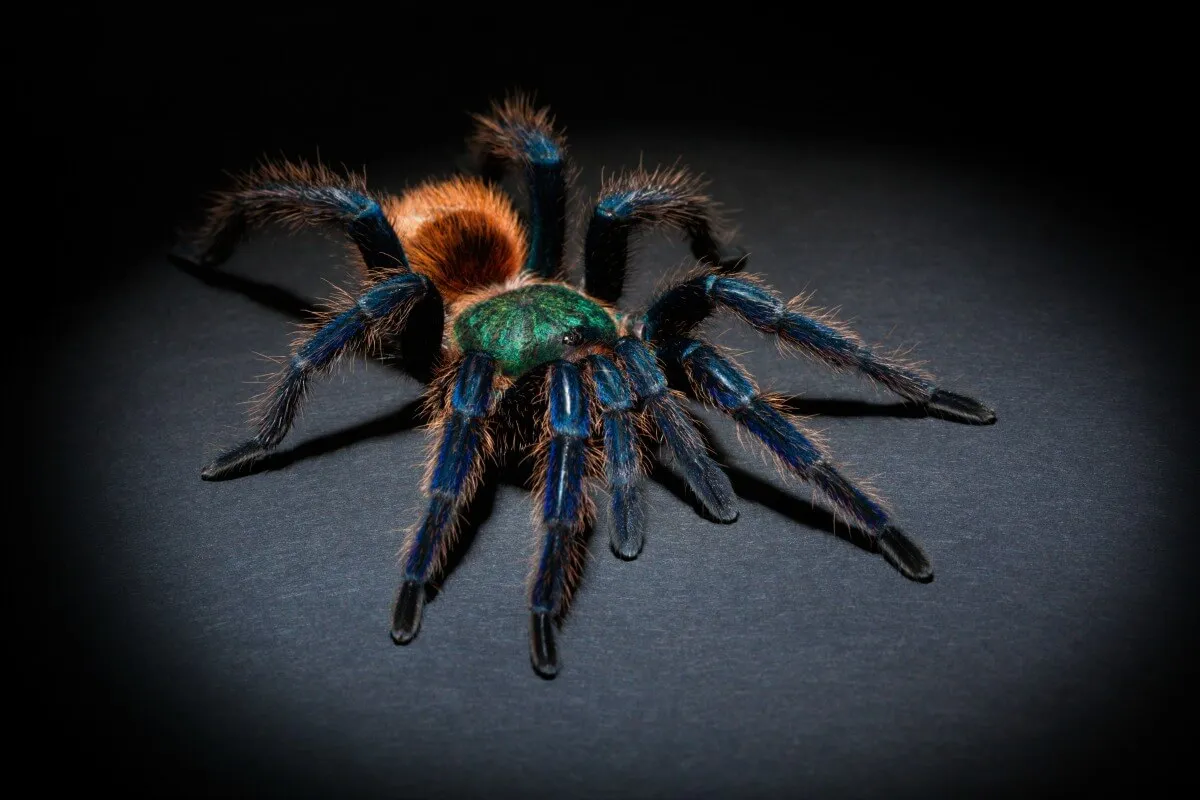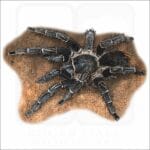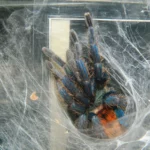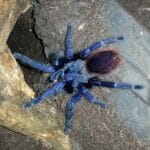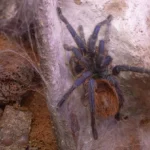Thinking of bringing a furry, eight-legged friend into your life? The Green Bottle Blue tarantula is a popular pick for beginners. With their eye-catching green and blue hues and a surprisingly easy-going nature, these tarantulas make great pets for those just starting out in the spider-keeping world. But before you make a commitment, let’s dive into all the ins and outs of keeping a Green Bottle Blue, from their special needs to whether they’re the right fit for you.
Are Green Bottle Blue Tarantulas Good for Beginners?
Green Bottle Blue Tarantulas (GBBTs) are like the rock stars of the tarantula world! With their stunning blue bodies and vibrant green legs, they’re a sight to behold. Plus, they’ve got a reputation for being pretty chill, which makes them tempting for first-time tarantula keepers. But are they truly beginner-friendly? Let’s dig in!
One of the biggest pluses for GBBTs is their generally laid-back attitude. They’re less likely to throw a tantrum and bite compared to some of their more high-strung cousins. This makes them a bit less intimidating for newbies who are still getting used to the whole “having a tarantula as a pet” thing.
Another bonus? GBBTs are relatively low-maintenance. They don’t need a fancy mansion, just a cozy enclosure with some hiding spots, a shallow water dish, and the right temperature and humidity levels (think tropical spa vibes). Feed them a diet of tasty insects, and they’ll be happy campers.
However, before you rush out to get a GBBT, there are a few things to keep in mind. While they aren’t usually aggressive, they can be a bit skittish. Imagine trying to handle a tiny, hairy supermodel – they might bolt at any sudden movement! This makes frequent handling a no-go, so if you’re looking for a cuddly companion, a GBBT might not be the best fit.
Want to discover more about the mysterious world of green bottle blue tarantulas? Click on the link to learn the secrets of this fascinating creature.
Key Points:
- Generally Docile: GBBTs are known for their relatively calm temperament and are less likely to bite than some other tarantula species.
- Low-Maintenance Care: They require basic housing, feeding, and climate control, making them manageable for beginners.
- Striking Appearance: Their vibrant blue and green coloration is a major draw for enthusiasts.
- Can Be Skittish: GBBTs are not the most handleable tarantulas and may startle easily, making them less suitable if you’re seeking a very interactive pet.
- Prone to Health Issues: Like all tarantulas, they are susceptible to certain health problems, so research and preparation are essential.
So, are Green Bottle Blue Tarantulas good for beginners? They can be, especially if you’re drawn to their beauty and prefer a more hands-off approach. But, it’s crucial to weigh the pros and cons and do your research to make sure a GBBT aligns with your lifestyle and expectations. There are plenty of other fantastic tarantula species out there, so take your time, explore your options, and find the perfect eight-legged friend for you!
Green Bottle Blue Tarantula Care: A Beginner-Friendly Guide
Are you curious about the aggression levels of blue green bottle tarantulas? Dive into the link and unravel the truth behind their temperament.
Key Takeaways:
- Green Bottle Blue Tarantulas are great for beginners because they’re pretty chill and don’t need a ton of fuss.
- They prefer things on the drier side, so good ventilation is key.
- A diverse menu of insects and other creepy crawlies, with a sprinkle of calcium, keeps them happy and healthy.
- While they’re not super high-maintenance, handle them with care to avoid stressing them out.
Let’s Talk Housing
Think desert vibes for these guys. They dig a dry environment with plenty of airflow to prevent things from getting stuffy. A comfortable temperature for them is around 75-85°F (24-29°C). When setting up their digs, use a substrate like vermiculite or potting soil that lets them burrow and feel at home.
Chow Time!
Young Green Bottle Blues are hungry little dudes, so feed them live insects like crickets or roaches a couple of times a week. Adults can handle a weekly feeding schedule. Don’t forget to dust those insects with calcium powder to keep their exoskeletons strong and healthy. A shallow water dish will quench their thirst.
Handling with Care (and Common Sense)
Now, while these tarantulas are generally laid-back, you still want to handle them gently. Avoid sudden movements or picking them up when they’re molting – it’s their version of a spa day! Clean hands are a must to prevent any harm. And, if you do happen to get bitten (unlikely, but hey, stuff happens!), contact a medical professional right away just to be safe.
Bonus Care Tips:
- Make sure their enclosure is roomy enough for exploring and hiding.
- Keep an eye on the humidity levels and adjust ventilation as needed.
- A clean enclosure equals a happy tarantula, so tidy up regularly to prevent any health issues.
- Don’t be afraid to reach out to experienced tarantula owners or check out reliable sources for more care tips.
Understanding Green Bottle Blue Tarantula Temperament and Handling
Have you wondered if green bottle blue tarantulas are aggressive? Explore the link and uncover the answer.
Key Takeaways:
- Green bottle blue tarantulas aren’t exactly known for their chill demeanor and might get a bit jumpy.
- Each one’s personality is unique – some are more relaxed than others.
- Always handle with care to avoid stressing them out or getting bitten.
So, you’re captivated by the Green Bottle Blue Tarantula’s (GBBT) stunning blue-green hues? They’re truly a sight to behold! But before you picture yourself casually handling this beauty, let’s talk about their personality. GBBTs are known to be a bit on the skittish side, which means they might not be the best cuddle buddies compared to some of their more easygoing tarantula cousins.
Now, keep in mind that every GBBT has its own quirks. Think of it like this: you wouldn’t expect every dog breed to act the same, right? Some GBBTs might be a tad more relaxed, while others might be quick to react. It all boils down to a mix of their genes, their upbringing, and how they’ve been treated in the past.
When it comes to handling these vibrant creatures, a gentle approach is key. Avoid any sudden movements or excessive handling that might make them feel threatened. Imagine being poked and prodded all the time – not exactly a recipe for a good mood! It’s especially important to give them space during molting, which is like their version of shedding skin. They’re extra vulnerable during this time and need a little extra TLC (tender loving care…or maybe “tender loving creepy crawly care” is more fitting!).
Remember, being a responsible owner means putting your GBBT’s well-being first. Sure, their looks are mesmerizing, but their health and happiness are what truly matter. By providing a comfy environment, minimizing stress, and handling them with the utmost care, you’ll be giving your GBBT the loving home it deserves.
Setting Up the Perfect Green Bottle Blue Tarantula Enclosure
So, you’re thinking about welcoming a dazzling Green Bottle Blue Tarantula (GBBT) into your life? Excellent choice! These guys are like living jewels with their vibrant blues and greens. But before you bring your new buddy home, let’s make sure their new digs are top-notch.
Creating a Comfortable Abode: Size and Hiding Spots
Think of it this way: your GBBT’s enclosure is their own little apartment. You want it to be spacious enough for them to stretch their legs (literally!) and have some privacy too. A good rule of thumb is to make sure the enclosure is at least three times longer than your tarantula’s leg span. That way, they’ll have plenty of room to roam. Speaking of roaming, GBBTs can be a little shy, even with their striking looks. They love having cozy spots to hide away. A simple half-log hide or a piece of cork bark does the trick perfectly. It makes them feel safe and secure, like they have their own little fortress of solitude.
The Ground Floor: Substrate Essentials
Now, let’s talk about the “floor” of your GBBT’s home – the substrate. Since these tarantulas prefer things on the drier side, you’ll want to choose a material that drains well, like vermiculite or even plain old potting soil. Avoid anything that holds onto moisture like a sponge, like sphagnum moss. Trust me, your GBBT won’t appreciate soggy feet!
Climate Control: Humidity and Temperature
Just like us, GBBTs have their preferred living conditions. They thrive in a dry environment with humidity levels hovering between 30% and 40%. A hygrometer will become your new best friend for keeping an eye on this. As for temperature, aim for a balmy 75°F to 85°F (24°C to 29°C). A simple thermometer will help you monitor this and make sure your GBBT stays comfortable.
On the Menu: Dining and Hydration for your GBBT
GBBTs might look fancy, but they are simple creatures at heart when it comes to mealtime. Live insects are their food of choice – think mealworms, crickets, and those protein-packed dubia roaches. Twice a week is perfect for youngsters, while adults are good with a weekly feast. And don’t forget a shallow water dish for your GBBT to rehydrate. Just make sure it’s shallow enough to prevent any accidental drowning.
Keeping it Spick and Span: Maintenance Made Easy
A clean home is a happy home, even for tarantulas! Remove any uneaten meals and droppings regularly. Think of it as tidying up after a messy roommate. Every six to eight months, give the enclosure a good deep clean with a reptile-safe disinfectant. It’ll keep your GBBT healthy and their home sparkling!
By following these simple steps, you’ll create a thriving environment for your Green Bottle Blue Tarantula. Remember, a happy tarantula is one that feels safe, secure, and well-fed.
- Georgia Platform: A Southern Strategy, 1850s - March 31, 2025
- How many weeks is 40 days: Quick Conversion Guide for Accurate Results - March 31, 2025
- How many feet is 300 meters? 984 Feet: Understand Length Conversions Easily - March 31, 2025
